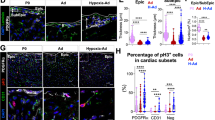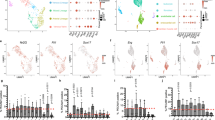Abstract
Mesenchymal lineage precursors can be reproducibly isolated from adult mammalian bone marrow and grown in culture. Immunoselection with monoclonal antibodies against STRO-1 and vascular-cell-adhesion molecule 1 (VCAM1/CD106) prior to expansion results in a 1,000-fold enrichment of mesenchymal precursors compared to standard isolation techniques. Intramyocardial injection of human STRO-1-selected precursors in an athymic rat model of acute myocardial infarction results in induction of vascular network formation and arteriogenesis coupled with global functional cardiac recovery.
This is a preview of subscription content, access via your institution
Access options
Subscribe to this journal
Receive 12 print issues and online access
$209.00 per year
only $17.42 per issue
Buy this article
- Purchase on Springer Link
- Instant access to full article PDF
Prices may be subject to local taxes which are calculated during checkout



Similar content being viewed by others
References
Drake CJ et al. (1998) Morphogenesis of the first blood vessels. Ann N Y Acad Sci 857: 155–179
Hungerford JE and Little CD (1999) Developmental biology of the vascular smooth muscle cell: building a multilayered vessel wall. J Vasc Res 36: 2–27
Bergwerff M et al. (1998) Neural crest cell contribution to the developing circulatory system: implications for vascular morphology? Circ Res 82: 221–231
Simmons PJ et al. (1994) Isolation, characterization and functional activity of human marrow stromal progenitors in hemopoiesis. Prog Clin Biol Res 89: 271–280
Filshie RJ et al. (1998) MUC18, a member of the immunoglobulin superfamily, is expressed on bone marrow fibroblasts and a subset of hematological malignancies. Leukemia 12: 414–421
Gronthos S et al. (2000) Postnatal human dental pulp stem cells (DPSCs) in vitro and in vivo. Proc Natl Acad Sci USA 97: 13625–13630
Gronthos S et al. (2003) Molecular and cellular characterisation of highly purified stromal stems derived from human bone marrow. J Cell Sci 116: 1827–1835
Shi S and Gronthos S (2003) Perivascular niche of postnatal mesenchymal stem cells in human bone marrow and dental pulp. J Bone Miner Res 18: 696–704
Benjamin LE et al. (1998) A plasticity window for blood vessel remodelling is defined by pericyte coverage of the preformed endothelial network and is regulated by PDGF-B and VEGF. Development 125: 1591–1598
Kocher AA et al. (2001) Neovascularization of ischemic myocardium by human bone-marrow-derived angioblasts prevents cardiomyocyte apoptosis, reduces remodeling and improves cardiac function. Nat Med 7: 430–436
Schuster MD et al. (2004) Myocardial neovascularization by bone marrow angioblasts results in cardiomyocyte regeneration. Am J Physiol Heart Circ Physiol 287: H525–H532
Klug MG et al. (1996) Genetically selected cardiomyocytes from differentiating embryonic stem cells form stable intracardiac grafts. J Clin Invest 98: 216–224
Hescheler J et al. (1999) Establishment of ionic channels and signalling cascades in the embryonic stem cell-derived primitive endoderm and cardiovascular system. Cells Tissues Organs 165: 153–164
Author information
Authors and Affiliations
Corresponding author
Ethics declarations
Competing interests
The authors declare no competing financial interests.
Rights and permissions
About this article
Cite this article
Martens, T., See, F., Schuster, M. et al. Mesenchymal lineage precursor cells induce vascular network formation in ischemic myocardium. Nat Rev Cardiol 3 (Suppl 1), S18–S22 (2006). https://doi.org/10.1038/ncpcardio0404
Received:
Accepted:
Issue Date:
DOI: https://doi.org/10.1038/ncpcardio0404
This article is cited by
-
Cellular Heterogeneity Facilitates the Functional Differences Between Hair Follicle Dermal Sheath Cells and Dermal Papilla Cells: A New Classification System for Mesenchymal Cells within the Hair Follicle Niche
Stem Cell Reviews and Reports (2022)
-
Safety and clinical efficacy of the secretome of stressed peripheral blood mononuclear cells in patients with diabetic foot ulcer—study protocol of the randomized, placebo-controlled, double-blind, multicenter, international phase II clinical trial MARSYAS II
Trials (2021)
-
Multimodal Imaging Reveals Improvement of Blood Supply to an Artificial Cell Transplant Site Induced by Bioluminescent Mesenchymal Stem Cells
Molecular Imaging and Biology (2017)
-
The effects of hypoxia on the stemness properties of human dental pulp stem cells (DPSCs)
Scientific Reports (2016)
-
Mesenchymal stem cell subpopulations: phenotype, property and therapeutic potential
Cellular and Molecular Life Sciences (2016)



